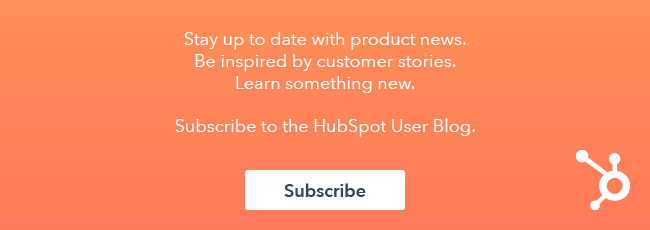Were you able to join us for HubSpot’s Four Days of Facebook online event this week?

In yesterday’s session, I talked with HubSpot senior product marketing manager Marcus Andrews about how buyer personas and Facebook targeted advertising go hand-in-hand. If you don’t have time to check out the recorded session, you can learn about the finer points of our discussion below. In this article, you’ll discover:
- Why buyer personas matter as you develop your marketing strategy
- How both demographics and psychographics will help you create robust buyer personas
- How to use your buyer personas for more targeted advertising, and
- How to build new Facebook lead ads in HubSpot
The Importance of Buyer Personas
Buyer personas are the heart of your inbound marketing strategy. Simply put, they're semi-fictional representations of an ideal customer, based on real data and some educated speculation about demographics, behaviors, motivations, and goals. They help you understand the mindset of your potential buyers so you know how to best reach and talk to them.
Developing persona profiles of your potential buyer(s) will help you:
- Develop the most effective marketing content
- Attract the ideal visitors to your website and social media channels
- Convert those visitors into leads, and
- Close them into customers
Sounds pretty good, right? If you’re a current Hubspot user, you may already be familiar with how to create buyer personas. But if not, never fear. Check out the handy dandy guide in our knowledge base. To make it easier, you can also download buyer persona templates here.
After you’ve done all that research, you should have a buyer story you can represent visually. It might look something like this:

Diving Deeper Into Your Buyer Persona for Social Advertising Targeting
In the world of Facebook, Twitter, Instagram and YouTube, we now have the ability to be hyper-specific when it comes to targeted advertising to our customers. But the buyer persona you develop needs a bit of fine tuning before you take this step. You need to think about adding in psychographics.
Psychographics measure customers’ attitudes and interests that go beyond general demographic data. Using psychographics helps you do smarter keyword targeting, particularly in the social space.
The questions you’ll ask will tend to be a bit more personal:
- What are their values and opinions? On religion, the environment, sports, the arts, religion, gender, politics, etc.?
- What brands do they identify with?
- What online sites do they visit? What types of books and magazines do they read?
- What are their hobbies?
- How tech savvy are they?
- Who or what influences their product choices?
- Where do they prefer to shop? What types of stores, locations, etc.?
You might be wondering where to begin to collect this type of deep data, but don’t worry. You likely have much of this information already. Most of it can be found in your blog and website comments, your sales data, email campaign results, industry reports, and social media conversations. And if that’s not enough, just ask. Conduct customer surveys, focus groups, or social media polls to help you find the data.
There is one additional place that might be one of the best sources of data for discovering this information —-- your social media insights.
In Twitter, you can look at your Audience insights and find out all kinds of fascinating bits of information about your users:

Facebook also has detailed Audience insights that will help you dig deep into categories of interest for your buyers.

How can this type of information augment your buyer persona? Check out the enhanced second page of Corporate Cathy’s persona:
Better Targeting Using Facebook Lead Ads
Determining this level of psychographic detail will help you immensely when it comes to specifically targeting the right kind of people you want to reach.
With this type of buyer persona information in hand, you can take your social media targeting to a whole new level, particularly with Facebook’s new lead ads. Facebook’s ad targeting focuses primarily on user interests, so you can reach exactly the audience you’re looking to attract.
For example, let’s say you are a marketer in the healthcare space. You’re looking to promote a new application that will connect patients with doctors who are taking new clients. Let’s pretend that Corporate Cathy is based on one of the buyer personas you’ve developed after your research. Based on the information in her profile, you can match up her interests to reach the right people in Facebook through their advertising tools. Instead of working primarily with general demographic information, you can dive much deeper. In the case of Corporate Cathy, you might want your first ad to reach women between the ages of 24-36 who are managers, make $70K+ a year, read Mashable (because she likes staying updated on new technologies), owns an iPhone (which is the best platform for your application), and owns a FitBit (she is predisposed to using a healthcare app). Then if you like, you could even do A/B testing on those ads and add in another parameter, those same targets plus women who are also into yoga.
Pretty detailed, right? And that’s exactly why Facebook ads are so powerful.
Facebook has also added the capability for advertisers to fill out a short form right in the ad itself, in their new lead ads. This takes Facebook ads to another level. Pairing your buyer persona and lead ads can quickly help you build a database of more qualified leads.
Marcus gives a great overview of lead ads in his recent blog post: Introducing Lead Ads for Facebook [Product Launch]
And if you’re ready to start building your advertising campaign, Marcus also has a fantastic five-minute walkthrough of how to create a lead ad.
For more information about buyer personas, check out the following HubSpot posts:
.jpg?width=640&name=Academy%20and%20Product%20Workshop%20-%20Day%203%20Four%20Days%20of%20Facebook%20(1).jpg)










